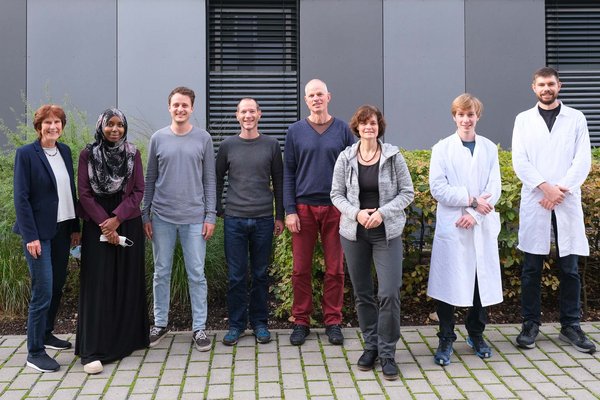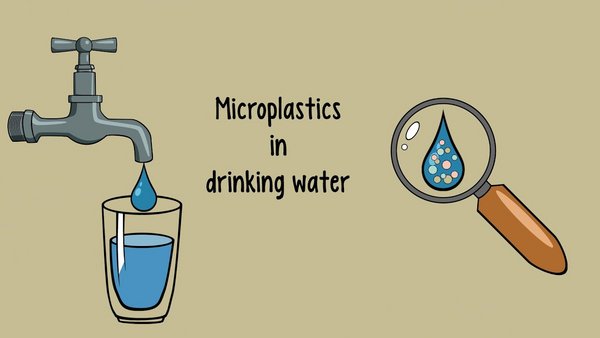Since 2015, research into the detection of microplastics has been conducted at the Institute of Environmental and Process Engineering (IUVT) under the supervision of Prof. Dr. Jutta Kerpen. The major research focus is on the analysis of microplastics in (industrial) wastewater by µ-Raman spectroscopy. In addition, the working group also investigates microplastics in other matrices, e.g. drinking water and surface waters (interview with Prof. Kerpen concerning this topic).
Current projects
- RAseR: Tire an Road Weare Particles in urban runoff and surface waters (since 2024)
Tire abrasion is considered the largest source of microplastics in the environment. The aim of the project is to quantify tire and road particles (TRWP) and the soluble substances in surface waters and road runoff systems. The retention capacity of technical infrastructure is determined and methods for optimized retention are developed. The project is being conducted in cooperation with the Institute for Analytical Research at Fresenius University of Applied Sciences. It is funded by the Hessian Ministry for the Environment, Climate Protection, Agriculture and Consumer Protection and the German Rubber Industry Association (wdk).
- Eintrag MiPa: Microplastics in waste water of the paper industry (since 2022)
Microplastics can be generated by recycling of paper, use of polymers in paper products, and plant and machine parts in the paper industry. In addition to the further development of an analysis method for the specific matrices of the paper industry, the aim of the research project is to identify sources of microplastics, to quantify emissions via the wastewater pathway and to check whether microplastics are also contained in products (e.g. food packaging).
The project is being realised in cooperation with the Institute for Paper Manufacture and Mechanical Process Engineering (PMV) at the TU Darmstadt.
Previous research projects
- Microplastics in surface water (2021 – 2022)
Investigation of Hessian surface waters for microplastics and validation of different sampling systems for the sampling of surface waters;
In cooperation with the Hessian State Agency for the Environment, Nature Conservation and Geology (HLNUG).
- EmiStop: Microplastics in industrial waste waters (2018 – 2021)
In the research project EmiStop, data on microplastics in industrial wastewater were systematically collected in cooperation with the TU Darmstadt and EnviroChemie GmbH, among others, for the first time. The project focused on plastics manufacturers, processing plants and large industrial parks. In addition to determining emissions from industrial wastewater treatment plants, separation systems such as sand filters and chamber filter presses were balanced and emissions via rainwater drainage were determined.
The complex industrial wastewater matrices and sometimes high microplastic concentrations made it necessary to develop a suitable analytical procedure, for example for taking representative sub-samples. This experience was included in the status paper on microplastic analysis.
The results show that the emissions of industrial wastewater treatment plants of industrial parks are in the range of municipal plants. With existing removal technology, such as sand filters and chamber filter presses, up to 99 % of the microplastics (< 10 µm) can be removed from the wastewater. The discharge of untreated rainwater from industrial plants into surface waters has been identified as a relevant source of microplastics (see Fig. 8).
- Microplastics in municipal waste water (2016 – 2018)
A method for the analysis of microplastics in the effluent of municipal wastewater treatment plants by µ-Raman spectroscopy was developed and the microplastic emissions of the wastewater treatment plant in Rüsselsheim were determined.
- Microplastics in drinking and mineral water (2017 – 2020)
In cooperation with the Public Services of Rüsselsheim, the drinking water in the Rüsselsheim drinking water network and at taps was examined. No microplastics ≥ 10 µm were detected.
Several studies have detected microplastics in mineral water. At the IUVT, the influence of the capping system of PET bottles on the microplastic concentration in water was investigated. It was proven that microplastics are created when the cap is opened/closed and that the concentration/uptake of microplastics increases with the number of these processes.
Publications
International Journals
- Weber, F.; Zinnen, A.; Kerpen, J.: Development of a machine learning‑based method for the analysis of microplastics in environmental samples using µ‑Raman spectroscopy. Microplastics and Nanoplastics 2023, 3:9. https://doi.org/10.1186/s43591-023-00057-3
- Barkmann-Metaj, L.; Weber, F.; Bitter, H.; Wolff, S.; Lackner, S.; Kerpen, J.; Engelhart, M.: Quantification of microplastics in wastewater systems of German industrial parks and their wastewater treatment plants. Science of the Total Environment 2023, 881, 163349. https://doi.org/10.1016/j.scitotenv.2023.163349
- Weber, F.; Kerpen, J.: Underestimating microplastics? Quantification of the recovery rate of microplastic particles including sampling, sample preparation, subsampling, and detection using µ-Ramanspectroscopy. Analytical and Bioanalytical Chemistry 2022. https://doi.org/10.1007/s00216-022-04447-z
- Giese, A.; Kerpen, J.; Weber, F.; Prediger, J.: A Preliminary Study of Microplastic Abrasion from the Screw Cap System of Reusable Plastic Bottles by Raman Microspectroscopy. ACS ES&T Water 2021, 1, 6. https://doi.org/10.1021/acsestwater.0c00238
- Wolff, S.; Weber, F.; Kerpen, J.; Winklhofer, M.; Engelhart, M.; Barkmann, L.: Elimination of Microplastics by Downstream Sand Filters in Wastewater Treatment. Water 2021, 13, 33. https://doi.org/10.3390/w13010033
- Weber, F.; Kerpen, J. Wolff, S; Langer, R.; Eschweiler, V.: Investigation of microplastics contamination in drinking water of a German city. Science of The Total Environment 2021, 755, 2. https://doi.org/10.1016/j.scitotenv.2020.143421
- Wolff, S.; Kerpen, J.; Prediger, J.; Barkmann, L.; Müller, L.: Determination of the microplastics emission in the effluent of a municipal waste water treatment plant using Raman microspectroscopy. Water Research X 2019, 2. https://doi.org/10.1016/j.wroa.2018.100014
National Journals
- Weber, F.; Wolff, S.; Kerpen, J.; Barkmann, L.: Regenentwässerung eines kunststoffverarbeitenden Industriebetriebs als Quelle für Mikroplastik. Mitt Umweltechem Ökotox 2020, 3, 26.
- Barkmann, L.; Bitter, H.; Wolff, S.; Weber, F.; Engelhart, M.; Kerpen, J.; Bitter, E.: Industrieller Eintrag von Mikroplastik in die Umwelt. Erste Erkenntnisse aus dem Projekt EmiStop. Korrespondenz Abwasser 2020, 67, 2.
Books
- Heß, M.; Völker, C.; Brennholt, N.; Herrling, P.M.; Hollert, H.; Ivleva, N.; Kerpen, J.; Laforsch, C.; Löder, M.; Schiwy, S.; Schmitz, M.; Wagner, S.; Hüffer, T.: Microplastics in the Aquatic Environment. In: Kramm, J.; Völker, C. (eds.): Living in the Plastic Age. Perspectives from Humanities, Social Sciences and Environmental Sciences. Campus Verlag. Frankfurt. New York. 2023. https://10.12907/978-3-593-44902-9
Miscellaneous
- Weber, F.; Kerpen, J.: Untersuchung der Mikroplastikprobenahme in Oberflächengewässern mittels Durchflusszentrifuge. Technischer Bericht. 2022. https://doi.org/10.25716/pur-44
- Hinzmann, M.; Knoblauch, D.; Mederake, L.; Schritt, H.; Stein, U. (Hrsg.): Kernbotschaften zum BMBF-Forschungsschwerpunkt „Plastik in der Umwelt“. 2022.
- Barkmann, L.; Bitter, E.; Bitter, H.; Czapla, J.; Engelhart, M.; Hunger, C.; Kerpen, J.; Lackner, S.; Masch, M.; Nunez, T.; Raber, W.; Steglich, A.; Weber, F.; Wolff, S.: EmiStop Schlussbericht. Identifikation von industriellen Plastik-Emissionen mittels innovativer Nachweisverfahren und Technologieentwicklung zur Verhinderung des Umwelteintrags über den Abwasserpfad. 2021.
- Barkmann, L.; Weber, F.; Raber, W.; Masch, M.; Wolff, S.; Bitter, H.; Bitter, E.; Kerpen, J.; Lackner, S.; Engelhart, M.: Industrielle Mikroplastikemissionen - Handlungsempfehlungen. 2021, https://dx.doi.org/10.26083/tuprints-00020230
- Braun, U. et al.: Statuspapier im Rahmen des Forschungsschwerpunktes Plastik in der Umwelt: Mikroplastik-Analytik. Probenahme, Probenaufbereitung und Detektionsverfahren. 2020.
![[Translate to English:] Industrielle Mikroplastikemissionen über den Abwasserpfad](/fileadmin/_processed_/0/f/csm_Abb8_7d3e3a1269.jpg)


![[Translate to English:] Probenahmeapparatur und Aufkonzentration der Probe mittels eines Edelstahlkerzenfilters](/fileadmin/Home/Fachbereiche/Ingenieurwissenschaften/Forschungsprofil/Labore/probenahmeapparatur-aufkonzentration-edelstahlkerzenfilter.jpg)
![[Translate to English:] Mikroplastik aus Abwasser eines Kunststoffherstellers vor der Probenaufbereitung](/fileadmin/Home/Fachbereiche/Ingenieurwissenschaften/Forschungsprofil/Labore/probenaufbereitung-mikroplastik-aus-abwasser-eines-kunststoffherstellers.jpg)
![[Translate to English:] Aufbereitete Mikroplastikprobe auf Analysefilter](/fileadmin/Home/Fachbereiche/Ingenieurwissenschaften/Forschungsprofil/Labore/fluoreszierende-partikel-aufbereitete-mikroplastikprobe-auf-analysefilter_01.jpg)

